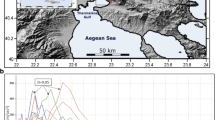Abstract
By virtue of their cost-effectiveness and ease of implementation in various practical situations, microseism-analysis methods are most widely used in seismic engineering surveys. It has been shown that analyzing the response of a structure to microseisms usually yields fairly complete information on its resonance properties and spectral ratio. An inherent disadvantage of impacting a structure with a field of microseisms is that seismic vibrations thus produced have small amplitudes, which in principle prevent detection of probable nonlinear responses from both the structure and soil strata to large earthquakes. To a certain extent, especially for small-sized structures, this disadvantage can be compensated by using the technique of artificial vibration impacts. The paper compares the results of applying microseism-analysis methods and the technique of artificial vibration impacts for seismic engineering survey of a typical small residential house. A vibratory roller is used as a source of impacts. This vibroroller enables simulation of impacts with an intensity of up to VI on the entire surveyed house and up to IX on some of its components. The two approaches have produced results that agree well in terms of the estimated characteristics of the structure. However, when studying soil strata with vibration impacts, an additional low-frequency diffuse maximum was observed with a period of 0.3–0.7 s, which overlapped the period of natural oscillations of the examined building in the E–W direction. This additional low-frequency period of soil strata oscillations can be due to either a boundary in soil at a depth of 20–30 m that generates resonant vibrations or the incipient soil liquefaction effect. With the available data, we find it difficult to choose between these two plausible explanations. The above comparisons indicate the limitations of conducting seismic engineering surveys by microseism-analysis methods. Based on the analysis, recommendations are given on the orientation for this type of buildings under construction.









Similar content being viewed by others
REFERENCES
Berzhinskii, Yu.A., Chernov, N.B., and Pavlenov, V.A., Use of seismic explosions and vibration tests on experimental samples for estimating possible damages in buildings in East Siberia, Vopr. Inzh. Seismol., 2008, vol. 35, no. 2, pp. 68–75.
Bindi, D., Boxberger, T., Orunbaev, S., Pilz, M., Stankiewicz, J., Pittore, M., Iervolino, I., Ellguth, E., and Parolai, S., On-site early-warning system for Bishkek (Kyrgyzstan), Ann. Geophys., 2015, vol. 58, no. 1. https://doi.org/10.4401/ag-6664
Chopra, A.K., Dynamics of Structures: Theory and Application to Earthquake Engineering, Upper Saddle River, N.J.: Prentice-Hall, 2007, 3rd ed.
Havskov, J., Test of Seismic Recorders with 4.5 Hz sensors: GBV316 from GeoSig and SL07 from SARA (Norw. Natl. Seism. Network Tech. Rep. no. 26), Bergen: Univ. Bergen, 2007.
Littler, J.D., Forced vibration tests on Sheffield University Arts Tower, Civil Engineering Dynamics: Analysis, Testing and Performance (Conference on Civil Engineering Dynamics), Bristol, UK, 1988, pp. 61–80.
Michel, C., Beatriz, Z., Pierino, L., Francisco, J., and Weber, F., Quantification of fundamental frequency drop for unreinforced masonry buildings from dynamic tests, Earthquake Eng. Struct. Dyn., 2011, vol. 40, no. 11, pp. 1283–1296. https://doi.org/10.1002/eqe.1088
Michel, C., Karbassi, P., and Lestuzzi, P., Evaluation of the seismic retrofitting of an unreinforced masonry building using numerical modeling and ambient vibration measurements, Eng. Struct., 2018, vol. 158, pp. 124–135. https://doi.org/10.1016/j.eng.struct.2017.12.016
Nakamura, Y.A., Method for dynamic characteristics estimation of subsurface using microtremor on the ground surface, Q. Rep. Railway Tech. Res. Inst., 1989, vol. 30, pp. 25–33.
Negmatullaev, S.Kh., Imitatsiya seismicheskogo vozdeistviya s tsel’yu ispytaniya zdanii i sooruzhenii na seismostoikost’ (Imitation of Seismic Effect in Order to Test Seismic Performance of Buildings and Structures), Sadovskii, M.A., Ed., Dushanbe: Donish, 1985.
Negmatullaev, S.Kh., Sadovskii, M.A., and Kikoin, I.K., Seismic performance tests for buildings and structures, Vestn. Akad. Nauk SSSR, 1985, no. 4, pp. 82–93.
Petrovic, B., Parolai, S., Pianese, G., Umit, D., Orunbaev, S., Moldobekov, B., and Paolucci, R., Joint deconvolution of building and downhole seismic recordings: an application to three test cases, Bull. Earthquake Eng., 2018, vol. 16, no. 2, pp. 613–641. https://doi.org/10.1007/s10518-017-0215-6
Shapiro, G.A., Ashkinadze, G.N., and Simon, Yu.A., Vibratsionnye metody ispytaniya zhilykh i obshchestvennykh zdanii (Vibration Methods for Testing Civil and), Moscow: Nauka, 1967.
Strollo, A., Parolai, S., Jäckel, K.H., and Bindi, D., Suitability of short-period sensors for retrieving reliable H/V peaks for frequencies less than 1 Hz, Bull. Seismol. Soc. Am., 2008, vol. 98, no. 2, pp. 671–681. https://doi.org/10.1785/0120070055
Ullah, S., Orunbaev, S., Bindi, D., Pittore, M., Pilz, M., Moldobekov, B., and Parolai, S., Improving the spatial resolution of ground motion variability using earthquake and seismic noise data: the example of Bishkek (Kyrgyzstan), Bull. Earthquake Eng., 2013, vol. 11, no. 2, pp. 385–399. https://doi.org/10.1007/s10518-012-9401-8
Yudakhin, F.N., Microseismic oscillations are important data source, Vestn. Ural. Otd. Ross. Akad. Nauk, 2010, no. 33, pp. 65–73. http://www.iieuran.ru/doc/33/65-73.pdf.
Author information
Authors and Affiliations
Corresponding authors
Additional information
Translated by V. Potapchouck
About this article
Cite this article
Orunbaev, S.Z., Mendekeyev, R.A., Moldobekov, B.D. et al. Microseismic and Vibroseismic Testing of a House: Comparative Study of Results with the Example of a Typical Privately Owned Residential House in Bishkek, Kyrgyzstan. Seism. Instr. 55, 92–100 (2019). https://doi.org/10.3103/S0747923919010122
Published:
Issue Date:
DOI: https://doi.org/10.3103/S0747923919010122




